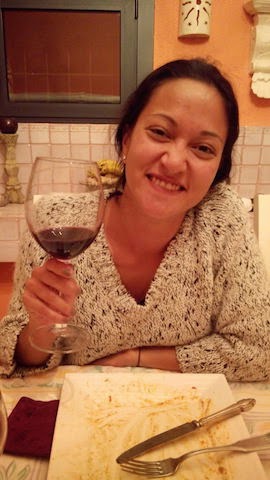On the 2nd of January I left Madrid for Catalunya via a seven hour bus, which wasn't so bad -- after the 22 hour bus ride in Peru, this was a piece of cake. I arrived at Barcelona Sants a little after 6pm and was on the 7pm high speed train to
Figueres, the city with the nearest train station to my aunt and cousin. Spain has slowly been building train stations and introducing the high speed trains called AVE. The trains are much nicer and faster, and as my aunt pointed out, sometimes only 2-4 euros more expensive than the normal trains.
My aunt picked me up at the train station in Figueres and we drove the 15 minutes to
Palau-Saverdera where they live. I met my cousin Maya and her boyfriend Nardi at home, and we all had a good dinner before calling it a night.
 |
Me: Let's take a picture to send to Ange
Maya: Wait, I need to hold a glass of wine! |
The next day we headed to
Roses to take a morning walk by the beach and I was pleasantly surprised by how warm it was! After La Rioja and Madrid's cold, it was a welcome change.
Figueres, Roses, and Palau-Saverdera are all cities in the province of
Girona. The autonomous community of
Catalunya is made up of four provinces:
Barcelona, Girona, Lleida and Tarragona. But here things get a bit tricky. Catalunya has long been known as the
comunidad wishing to be independent from Spain, and do things a bit differently there (most notably the wide use of Catalan instead of Castillian Spanish). So while Spain divides Catalunya into the four provinces, Catalunya has their own division:
comarques (singular '
comarca'). So for instance under the Spanish division, Figueres, Roses, Palau-Saverdera, and the city of Girona are considered part of the province Girona. But under Catalunya's division, Figueres Roses and Palau-Saverdera belong to the
comarca l'Alt Empordà while Girona is part of the
comarca el Gironès. It was a bit confusing to understand, but made for some interesting research.
But anyway. We drove into
Roses (the city center is just about 10 minutes from Palau-Saverdera), parked the car, and took a walk along the beach. It was so sunny and warm out. I just had a hoodie over my t-shirt, and, later on, it was warm enough for me to take off my hoodie. The beach was beautiful, and as it was winter there were scarcely any people. Just some two or three locals crazy enough to take a dip in the water and a few other morning joggers and walkers. (Though my aunt tells me it gets
crowded in the summer. I can imagine, as even in the winter it's beautiful, just cold). Roses is an important fishing port, and in the summer, a sought after tourist destination. (Fun fact: it was where the now-closed
elBulli was, the famous Michelin three-star restaurant of Ferran Adrià).
 |
| This is my kind of winter! I'll take the sun and sand over the snow and cold any day. |
 |
| Had some great conversation (and a workout) catching up with Maya and Tita Patricia whom I hadn't seen in a few years. |
We had lunch back in Palau-Saverdera where my
tito owns a restaurant
Nou Fusion. Again, it was so nice out so we had lunch on the terrace of the house.
We spent the afternoon just relaxing at home. The next day we decided to drive out to Cadaqués. Yet again we were blessed with great weather so we took my tito's convertible and rode with the top down. It was just slightly cold, but it was a good drive through the mountains (or are they hills?) to get to Cadaqués.
Along with the rest of the municipalities of l'Alt Empordà and several other comarques, Cadaqués is part of the Costa Brava, the rugged coastal region along northeastern Spain. It's a beautiful small town made of up predominantly white houses and cobblestone streets.
The famous
Salvador Dalí (born in Figueres) spend much of his childhood in Cadaqués. He and his wife Gala later built a home in a small village nearby. Many other artists who resided in Catalunya would often visit Cadaqués as well including Pablo Picasso and Joan Miró, and there were plaques around the city showing which houses they lived in.
 |
| Statue of Dalí in the center near the coast |
Cadaqués also had some immigrants from Cuba who constructed huge beautiful houses in the city. Some of these houses are still standing such as the
Casa Blava ("Blue House" in Catalan) pictured below.
We had some
merienda on the terrace of a restaurant overlooking the beach then headed to Port Lligat to vist Dalí's house.
Port Lligat is a small village, still in the municipality of Cadaqués, located in a small bay. The bay and the village can be seen in several of Dalí's paintings. Dalí and his wife Gala lived here and their house has since been converted into a museum. While the house doesn't display many of his works, it gives some insight into the kind of man Dalí was and the kind of life he lived.
 |
| Casa-Museo Salvador Dalí |
Dalí's surrealistic style and eccentricity is evident all over his house. His behavior was so eccentric that it drew as much attention as his work did.
 |
| Eggs, which is an important Dalian symbol, are present all over his house |
 |
| Eccentricities in Dalí's house |
To be honest, Dalí is not one of my favorite artists, but it was still quite interesting to learn about his life, and gain some insight into how his thoughts and experiences influenced his work.

















Comments